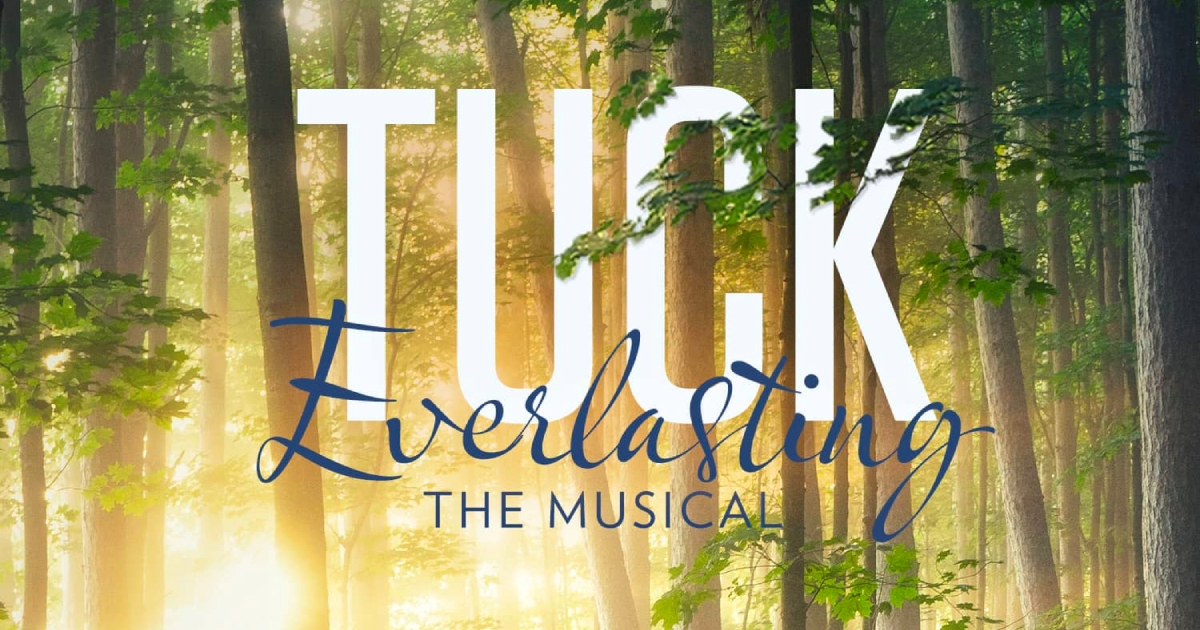What if you could live forever?
This is the idea around which the whimsical musical “Tuck Everlasting”, currently in production at Hope Repertory Theatre under direction from new Artistic Director Marcus Denard Johnson, dances. Sometimes beautifully and other times confusingly, this adaptation of the 1975 children’s novel that was also adapted twice for film, is both lovely and flawed—much like life as well as death, and in this fantastical world on stage the two are inextricably intertwined.
Set in 19th Century small-town New Hampshire, the story focuses on Winnie, an adventurous 11-year-old girl who is stifled and housebound by her grieving mother. She runs away to the woods and stumbles upon a teenage boy drinking from a spring that turns out to be a fountain of youth. Jesse, who appears to be 17, has actually been alive for 102 years thanks to sipping that magic water, and the rest of his family, the Tucks, are also stuck in the bodies and ages they were when they first quenched their thirst. Winnie wants to drink the water, too, but Jessie convinces her to wait—at least until she’s a teenager too—so they can be immortal, and ostensibly romantic, together.
It’s a little bit creepy for a 17 year old to have eyes for an 11 year old, especially when he’s really 102. But if one lives forever in a youthful body can wisdom still be attained?
It is hard to tell with the Tuck family who have suffered for having been imprisoned in the woods as well as in their bodies and lives. Immortality is not at all what it’s cracked up to be for the Tucks, and so the central tension of the show: will Winnie drink from the spring or will she not—isn’t much of a question at all.
A peripheral tension, that of the sinister Man in the Yellow Suit (Chip DuFord), a carnie from the fair who wants to capitalize on the fountain of youth and destroy the Tucks in the process, is also too quickly dispelled.
Which leaves the show as a sentimental reflection on life and death as we know it. In one scene after a musical number with the lyric “You can’t have living without dying”, Jessie’s father Angus says, “Don’t be afraid of death, Winnie. Be afraid of not being truly alive. You don’t need to live forever, you just need to live.”
The message is clear, and it’s delivered largely through folk and country-infused songs that though sung quite beautifully by a strong central cast, have a sameness in their anthem-ballad quality; and though the arrangements by Chris Miller are quite complicated and the orchestra, led by Music Director Dan Rutzen, sounds great, the songs are ultimately forgettable.
However, Abigail Douglas is a wonderfully spunky Winnie, capturing her childlike qualities while also possessing a powerful voice. She is wonderful with Henry Crater as Jesse—their energy and enthusiasm well matched and their voices glorious together.
Bailey Seeker as Mae and Michael Niederer as Angus also make for a lovely couple; and Corey Barlow’s one solo as Miles isn’t nearly enough. Their voices soar and they make beautiful music together.
Another bright spot in this production is the realness brought to the stage by Oscar Izenson as Constable Joe. He offers comic relief as well as a believable character amid fantasy for a standout performance.
However, the lead actors all seem to be about the same age, which also is about the same age as the entire cast, save for the two obviously older cast members, which makes many of the relationships as intended somewhat unbelievable.
There’s a lot of suspension of disbelief required in this show, only some of which is actually possible. Stephen Hudson-Mairet’s sets allow for movement between the woods, town, and a lively fair, and though there is a huge climbing tree upstage left and an image of a giant cut tree rings painted on the floor, there isn’t the feeling of being nestled and hidden in the woods. Visually things are working more symbolically.
Including the choreography by Dewitt Cooper, the best of which comes at the start of the show with period partner dances that are especially appealing with Anthony Paul-Cavaretta’s costumes. The innovative climax of the show comes in the form of dance with a wordless vision of Winnie’s life as it will unfold—a rich tumble toward death (complete with a twirling tombstone) full of marriages and births: the circle, if not tree, of life—danced by representative ensemble members. But this dream ballet is by no means the work of Agnes de Mille and it falls short of its aspiration here.
However, the ideas that drive “Tuck Everlasting” are well worth pondering, and this production offers a sweet opportunity for audiences to contemplate what it means to truly live, especially in the face of death’s inevitability. And it does so in a whimsical, family-friendly way shot through with beautiful singing.
Tuck Everlasting
Hope Summer Repertory Theatre
141 E. 12th St., Holland
June 17-July 14
hope.edu





